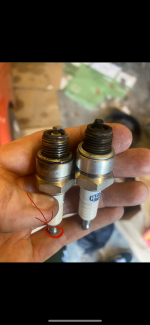StefP0342
Member
Hi,
See attached the picture of the spark plugs. Spark plug to the front of the car has black deposits, while the plug towards the rear of the car looks normal (i suppose). Car runs well, to be sure i let it be inspected by a mechanic. He told me nothing is wrong with the car. Considering there is just 1 air/fuel intake, it can’t be a fuel mixture that is too rich, right?
Curious for your opinion, thanks!
See attached the picture of the spark plugs. Spark plug to the front of the car has black deposits, while the plug towards the rear of the car looks normal (i suppose). Car runs well, to be sure i let it be inspected by a mechanic. He told me nothing is wrong with the car. Considering there is just 1 air/fuel intake, it can’t be a fuel mixture that is too rich, right?
Curious for your opinion, thanks!



